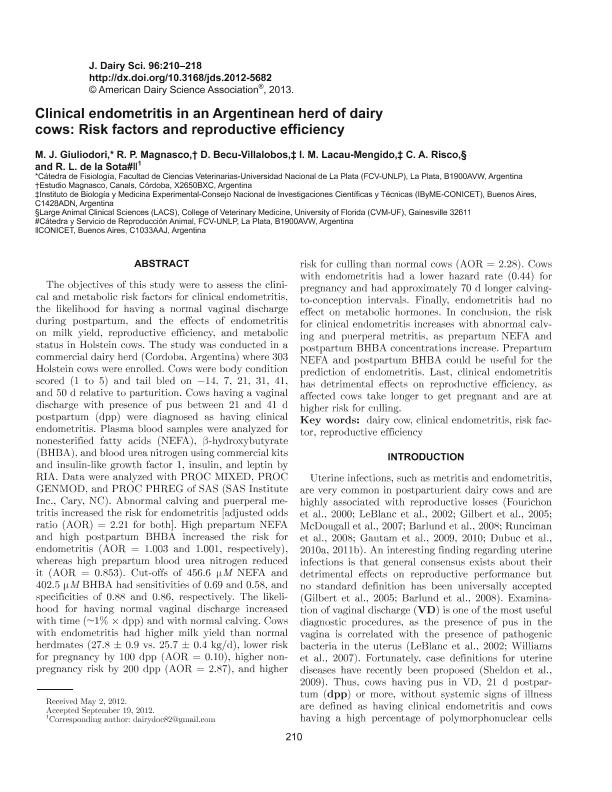Artículo
Clinical endometritis in an Argentinean herd of dairy cows: Risk factors and reproductive efficiency
Giuliodori, Mauricio Javier; Magnasco, R. P.; Becu, Damasia ; Lacau, Isabel María
; Lacau, Isabel María ; Risco, C. A.; de la Sota, Rodolfo Luzbel
; Risco, C. A.; de la Sota, Rodolfo Luzbel
 ; Lacau, Isabel María
; Lacau, Isabel María ; Risco, C. A.; de la Sota, Rodolfo Luzbel
; Risco, C. A.; de la Sota, Rodolfo Luzbel
Fecha de publicación:
11/2012
Editorial:
Elsevier
Revista:
Journal of Dairy Science
ISSN:
0022-0302
Idioma:
Inglés
Tipo de recurso:
Artículo publicado
Clasificación temática:
Resumen
The objectives of this study were to assess the clinical and metabolic risk factors for clinical endometritis, the likelihood for having a normal vaginal discharge during postpartum, and the effects of endometritis on milk yield, reproductive efficiency, and metabolic status in Holstein cows. The study was conducted in a commercial dairy herd (Cordoba, Argentina) where 303 Holstein cows were enrolled. Cows were body condition scored (1 to 5) and tail bled on −14, 7, 21, 31, 41, and 50 d relative to parturition. Cows having a vaginal discharge with presence of pus between 21 and 41 d postpartum (dpp) were diagnosed as having clinical endometritis. Plasma blood samples were analyzed for nonesterified fatty acids (NEFA), β-hydroxybutyrate (BHBA), and blood urea nitrogen using commercial kits and insulin-like growth factor 1, insulin, and leptin by RIA. Data were analyzed with PROC MIXED, PROC GENMOD, and PROC PHREG of SAS (SAS Institute Inc., Cary, NC). Abnormal calving and puerperal metritis increased the risk for endometritis [adjusted odds ratio (AOR) = 2.21 for both]. High prepartum NEFA and high postpartum BHBA increased the risk for endometritis (AOR = 1.003 and 1.001, respectively), whereas high prepartum blood urea nitrogen reduced it (AOR = 0.853). Cut-offs of 456.6 μM NEFA and 402.5 μM BHBA had sensitivities of 0.69 and 0.58, and specificities of 0.88 and 0.86, respectively. The likelihood for having normal vaginal discharge increased with time (∼1% × dpp) and with normal calving. Cows with endometritis had higher milk yield than normal herdmates (27.8 ± 0.9 vs. 25.7 ± 0.4 kg/d), lower risk for pregnancy by 100 dpp (AOR = 0.10), higher nonpregnancy risk by 200 dpp (AOR = 2.87), and higher risk for culling than normal cows (AOR = 2.28). Cows with endometritis had a lower hazard rate (0.44) for pregnancy and had approximately 70 d longer calving-to-conception intervals. Finally, endometritis had no effect on metabolic hormones. In conclusion, the risk for clinical endometritis increases with abnormal calving and puerperal metritis, as prepartum NEFA and postpartum BHBA concentrations increase. Prepartum NEFA and postpartum BHBA could be useful for the prediction of endometritis. Last, clinical endometritis has detrimental effects on reproductive efficiency, as affected cows take longer to get pregnant and are at higher risk for culling.
Palabras clave:
Dairy Cow
,
Clinical Endometritis
,
Risk Factors
,
Reproductive Efficiency
Archivos asociados
Licencia
Identificadores
Colecciones
Articulos(CCT - LA PLATA)
Articulos de CTRO.CIENTIFICO TECNOL.CONICET - LA PLATA
Articulos de CTRO.CIENTIFICO TECNOL.CONICET - LA PLATA
Articulos(IBYME)
Articulos de INST.DE BIOLOGIA Y MEDICINA EXPERIMENTAL (I)
Articulos de INST.DE BIOLOGIA Y MEDICINA EXPERIMENTAL (I)
Citación
Giuliodori, Mauricio Javier; Magnasco, R. P.; Becu, Damasia; Lacau, Isabel María; Risco, C. A.; et al.; Clinical endometritis in an Argentinean herd of dairy cows: Risk factors and reproductive efficiency; Elsevier; Journal of Dairy Science; 96; 1; 11-2012; 210-218
Compartir
Altmétricas



